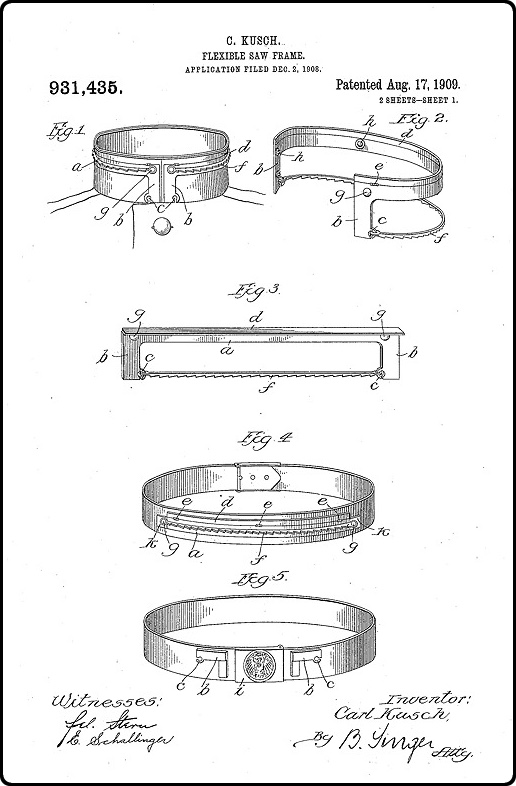Patents
Underwear-concealed survival saw
If you find yourself held hostage, there's a newly patented invention (No. 12,059,045) that may help you escape to freedom. It's an underwear-concealed survival saw.The flexible saw can be concealed in almost any undergarment ("undershirt; boxers/briefs, camisole or brassiere"). It's possible to retrieve the saw even while wearing handcuffs. Then you can use it to cut through zip ties, ropes, wood, or even light metals.


The underwear-concealed saw bears some resemblance to an oddball invention we've previously posted about: the collar saw of Carl Kusch.

Posted By: Alex - Sat Aug 24, 2024 -
Comments (4)
Category: Fashion, Patents
Electric Dumb Bell
Couldn't you achieve the same thing by just sticking your finger in a wall socket while exercising?Full patent here.


Posted By: Paul - Sun Aug 18, 2024 -
Comments (1)
Category: Exercise and Fitness, Patents, 1920s, Bodybuilding, Pain, Self-inflicted and Otherwise
Novelty Wig
FINALLY, I can achieve the effect so often seen in cartoons and gag panels!Full patent here.

Posted By: Paul - Fri Aug 16, 2024 -
Comments (4)
Category: Wigs, Hairpieces, Fake Eyelashes, Implants, and other Prosthetics, Patents, 1920s, Pranks
Double-standard DWI-rules game
Emil Richard Rossi was granted a patent (No. 6,412,777) in 2002 for his "Double-standard DWI-rules" board game.One purpose of the game was to teach players about drunk-driving laws and the financial consequences of drunk driving. Its second purpose was to demonstrate the "double-standard" of drunk-driving enforcement. Or, as he put it, the "Special treatment for drunk-driving offenders according to their Social Status."
Sounds like Rossi had a bone to pick with the way drunk-driving laws are enforced.
No surprise, his game was never produced by a commercial board game manufacturer, but according to boardgamegeek.com he did self-publish the game. So perhaps a copy of it might be available in a second-hand store somewhere.

From his patent description:
The object of the game disclosed herein, is to provide amusement for the players while they acquaint themselves with the financial liability incurred by being arrested for driving drunk. It is also is an object of the game is to provide amusement for the players while they acquaint themselves with the behind the Scene manipulations resulting in Special treatment for drunk-driving offenders according to their Social Status.


Posted By: Alex - Wed Aug 14, 2024 -
Comments (1)
Category: Games, Inebriation and Intoxicants, Police and Other Law Enforcement, Patents, 2000s, Cars
The Guitar-Xylophone
A guitar with an attached xylophone! Perfect for one-man bands!Original patent here.



Posted By: Paul - Sat Aug 10, 2024 -
Comments (0)
Category: Inventions, Chindogu, Patents, Music, 1920s
Electro-Vibratory Bodysuit
A full suit of electrical stimulators and vibrators to cure your charley-horses.Full patent here.



Posted By: Paul - Tue Aug 06, 2024 -
Comments (2)
Category: Body, Inventions, Patents, Technology, Twenty-first Century
Combined Woodworker’s Push-Stick and Furniture Alarm Unit
British inventor David Bartram was granted a UK patent (GB2233932A) in 1989 for his "woodworker's push-stick and furniture alarm unit."In its first possible use, as a push-stick, his invention allowed woodworkers to push pieces of wood through a table saw while keeping their hand safely away from the saw blade.

In its second possible use, as a furniture alarm, the stick could be attached in between the legs of a chair. If the occupant of the chair happened to lean backwards, raising the front legs of the chair off the ground, the furniture alarm would emit a "startling warning."

Bartram clearly was annoyed by people who leaned backwards in chairs. He wrote:
Of course, for his invention to function as a furniture alarm some kind of "gravity-orientated switch" would need to be incorporated into it. Based on his patent description, it's not clear if Bartram had ever gone to the trouble of doing this, but it seems that he didn't anticipate it would be a problem.
He didn't address the major limitation of his two-in-one invention: if you've got it attached to the legs of a chair it's not available to use as a push-stick, and vice versa, if it's in your workshop being used as a push-stick, it's not guarding a chair.
Posted By: Alex - Wed Jul 31, 2024 -
Comments (4)
Category: Furniture, Patents, 1980s
Butt Irrigator
Complete patent here.


Posted By: Paul - Fri Jul 26, 2024 -
Comments (1)
Category: Body, Diseases, Domestic, Hygiene, Inventions, Patents, 1960s
Lip Stencil
Beauty aid or torture device?
Posted By: Alex - Sun Jul 21, 2024 -
Comments (0)
Category: Beauty, Ugliness and Other Aesthetic Issues, Patents, 1930s
Toaster That Butters the Toast
Man, given the laziness of the average person, this should have been a bestselling item. Unless...the notion of a reservoir full of old butter sitting at room temperature for weeks was a turn-off.Full patent here.


Posted By: Paul - Mon Jul 15, 2024 -
Comments (3)
Category: Domestic, Food, Inventions, Patents, Technology, 1960s

| Who We Are |
|---|
| Alex Boese Alex is the creator and curator of the Museum of Hoaxes. He's also the author of various weird, non-fiction, science-themed books such as Elephants on Acid and Psychedelic Apes. Paul Di Filippo Paul has been paid to put weird ideas into fictional form for over thirty years, in his career as a noted science fiction writer. He has recently begun blogging on many curious topics with three fellow writers at The Inferior 4+1. Contact Us |




